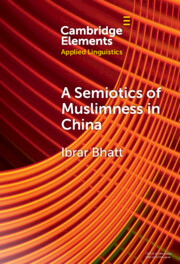Element contents
A Semiotics of Muslimness in China
Published online by Cambridge University Press: 29 November 2023
Summary
- Type
- Element
- Information
- Series: Elements in Applied LinguisticsOnline ISBN: 9781009415910Publisher: Cambridge University PressPrint publication: 21 December 2023
References
- 4
- Cited by



